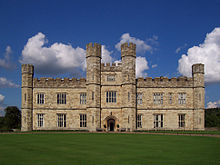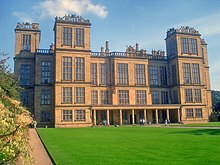
Back عمارة تيودورية Arabic Tüdor stili Azerbaijani Тюдорски стил Bulgarian Estil Tudor Catalan Tudorstil German Tudorstilo Esperanto Estilo Tudor Spanish Tuudorstiil Estonian معماری تودور Persian Tudor-tyyli Finnish



The Tudor architectural style is the final development of medieval architecture in England and Wales, during the Tudor period (1485–1603) and even beyond, and also the tentative introduction of Renaissance architecture to Britain. It followed the Late Gothic Perpendicular style and, gradually, it evolved into an aesthetic more consistent with trends already in motion on the continent, evidenced by other nations already having the Northern Renaissance underway Italy, and especially France already well into its revolution in art, architecture, and thought. A subtype of Tudor architecture is Elizabethan architecture, from about 1560 to 1600, which has continuity with the subsequent Jacobean architecture in the early Stuart period.
In the much more slow-moving styles of vernacular architecture, "Tudor" has become a designation for half-timbered buildings, although there are cruck and frame houses with half-timbering that considerably predate 1485 and others well after 1603; an expert examination is required to determine the building's age. In many regions stone architecture, which presents no exposed timber on the facade, was the norm for good houses, while everywhere the poorest lived in single-storey houses using wood frames and wattle and daub, too flimsy for any to have survived four centuries. In this form, the Tudor style long retained its hold on English taste.[1] Nevertheless, "Tudor style" is an awkward style-designation, with its implied suggestions of continuity through the period of the Tudor dynasty and the misleading impression that there was a style break at the accession of James I in 1603, first of the House of Stuart. A better diagnostic is the "perpendicular" arrangement of rectangular vertically oriented leaded windows framed by structural transoms and mullions and often featuring a "hooded" surround usually in stone or timber such as oak.
The low multi-centred Tudor arch was another defining feature and the period sees the first introduction of brick architecture imported from the Low Countries. Some of the most remarkable oriel windows belong to this period.[1] Mouldings are more spread out and the foliage becomes more naturalistic. During the reigns of Henry VIII and Edward VI, many Italian artists arrived in England; their decorative features can be seen at Hampton Court Palace, Layer Marney Tower, Sutton Place, and elsewhere. However, in the following reign of Elizabeth I, the influence of Northern Mannerism, mainly derived from books, was greater. Courtiers and other wealthy Elizabethans competed to build prodigy houses that proclaimed their status.
The Dissolution of the Monasteries redistributed large amounts of land to the wealthy, resulting in a secular building boom, as well as a source of stone.[2] The building of churches had already slowed somewhat before the English Reformation, after a great boom in the previous century, but was brought to a nearly complete stop by the Reformation. Civic and university buildings became steadily more numerous in the period, which saw general increasing prosperity. Brick was something of an exotic and expensive rarity at the beginning of the period, but during it became very widely used in many parts of England, even for modest buildings, gradually restricting traditional methods such as wood framed, daub and wattle and half-timbering to the lower classes by the end of the period.
Scotland was a different country throughout the period and is not covered here, but early Renaissance architecture in Scotland was influenced by close contacts between the French and Scottish courts, and there are a number of buildings from before 1560 that show a more thorough adoption of continental Renaissance styles than their English equivalents.
- ^ a b One or more of the preceding sentences incorporates text from a publication now in the public domain: Chisholm, Hugh, ed. (1911). "Tudor Period". Encyclopædia Britannica. Vol. 27 (11th ed.). Cambridge University Press. p. 363.
- ^ Cite error: The named reference
LizaPicardwas invoked but never defined (see the help page).